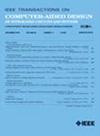集成电路物理设计知识产权保护的稳健水印框架
IF 2.9
3区 计算机科学
Q2 COMPUTER SCIENCE, HARDWARE & ARCHITECTURE
IEEE Transactions on Computer-Aided Design of Integrated Circuits and Systems
Pub Date : 2025-03-18
DOI:10.1109/TCAD.2025.3552503
引用次数: 0
摘要
现代集成电路版图上的物理设计水印(WM)对签名进行编码时没有考虑密集连接和设计约束,这可能导致水印产品的性能下降。本文介绍了ICMarks,这是一种用于现代IC物理设计的质量保持和健壮的WM框架。ICMarks在物理设计的放置阶段嵌入唯一的水印签名,从而验证IC布局的所有权。ICMarks的新颖之处在于:1)在对布局性能影响最小的情况下战略性地识别要水印的细胞区域;2)一个两级WM框架,增强了对潜在移除和伪造攻击的鲁棒性。对不同设计目标和尺寸的基准进行了广泛的评估,验证了ICMarks在成功证明所有权的同时,不会导致无线和定时指标的下降。此外,我们证明ICMarks对两种主要的WM攻击类别具有鲁棒性,即水印去除和伪造攻击;即使攻击者事先知道WM方案,也不能在不显著破坏布局质量的情况下删除签名。本文章由计算机程序翻译,如有差异,请以英文原文为准。
ICMarks: A Robust Watermarking Framework for Integrated Circuit Physical Design IP Protection
Physical design watermarking (WM) on contemporary integrated circuit (IC) layout encodes signatures without considering the dense connections and design constraints, which could lead to performance degradation on the watermarked products. This article presents ICMarks , a quality-preserving and robust WM framework for modern IC physical design. ICMarks embeds unique watermark signatures during the physical design’s placement stage, thereby authenticating the IC layout ownership. ICMarks ’s novelty lies in 1) strategically identifying a region of cells to watermark with minimal impact on the layout performance and 2) a two-level WM framework for augmented robustness toward potential removal and forging attacks. Extensive evaluations on benchmarks of different design objectives and sizes validate that ICMarks incurs no wirelength and timing metrics degradation, while successfully proving ownership. Furthermore, we demonstrate ICMarks is robust against two major WM attack categories, namely, watermark removal and forging attacks; even if the adversaries have prior knowledge of the WM schemes, the signatures cannot be removed without significantly undermining the layout quality.
求助全文
通过发布文献求助,成功后即可免费获取论文全文。
去求助
来源期刊
CiteScore
5.60
自引率
13.80%
发文量
500
审稿时长
7 months
期刊介绍:
The purpose of this Transactions is to publish papers of interest to individuals in the area of computer-aided design of integrated circuits and systems composed of analog, digital, mixed-signal, optical, or microwave components. The aids include methods, models, algorithms, and man-machine interfaces for system-level, physical and logical design including: planning, synthesis, partitioning, modeling, simulation, layout, verification, testing, hardware-software co-design and documentation of integrated circuit and system designs of all complexities. Design tools and techniques for evaluating and designing integrated circuits and systems for metrics such as performance, power, reliability, testability, and security are a focus.

 求助内容:
求助内容: 应助结果提醒方式:
应助结果提醒方式:


